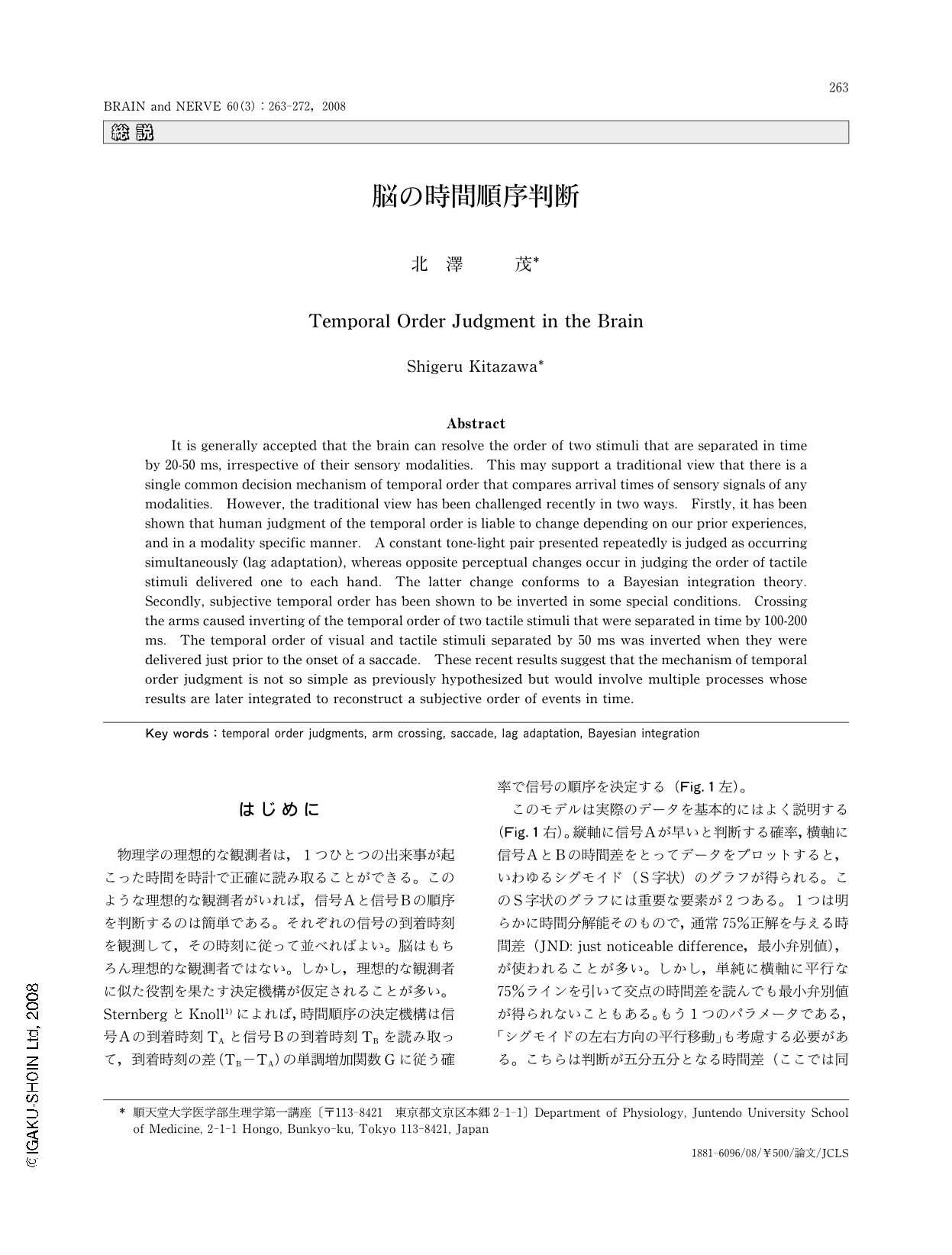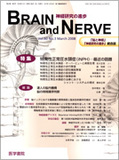Japanese
English
- 有料閲覧
- Abstract 文献概要
- 1ページ目 Look Inside
- 参考文献 Reference
はじめに
物理学の理想的な観測者は,1つひとつの出来事が起こった時間を時計で正確に読み取ることができる。このような理想的な観測者がいれば,信号Aと信号Bの順序を判断するのは簡単である。それぞれの信号の到着時刻を観測して,その時刻に従って並べればよい。脳はもちろん理想的な観測者ではない。しかし,理想的な観測者に似た役割を果たす決定機構が仮定されることが多い。SternbergとKnoll1)によれば,時間順序の決定機構は信号Aの到着時刻TAと信号Bの到着時刻TBを読み取って,到着時刻の差(TB-TA)の単調増加関数Gに従う確率で信号の順序を決定する(Fig.1左)。
このモデルは実際のデータを基本的にはよく説明する(Fig.1右)。縦軸に信号Aが早いと判断する確率,横軸に信号AとBの時間差をとってデータをプロットすると,いわゆるシグモイド(S字状)のグラフが得られる。このS字状のグラフには重要な要素が2つある。1つは明らかに時間分解能そのもので,通常75%正解を与える時間差(JND: just noticeable difference,最小弁別値),が使われることが多い。しかし,単純に横軸に平行な75%ラインを引いて交点の時間差を読んでも最小弁別値が得られないこともある。もう1つのパラメータである,「シグモイドの左右方向の平行移動」も考慮する必要がある。こちらは判断が五分五分となる時間差(ここでは同時点と呼ぶ)である。古典モデルでは,同時点は感覚器から決定機構に到達するまでの経路の時間差を反映するとされた1)。時間分解能は,この同時点から75%正解点までの時間差と定義するのがよい1)。最小弁別値に関しては,経験を積んだ被験者では感覚の種類(視覚,聴覚,触覚)の組み合わせによらずほぼ一定で,20~30ms程度であるとされてきた2,3)。また,同時点の0からのずれは,数ミリ秒程度のものが報告されていた4)。つまり,古典的には時間差0近辺で判断が五分五分となるシグモイドで,ほとんどすべてのデータを説明することができたのである。
しかし近年になって,これら古典的な知見を拡張する現象が相次いで報告されている。「同時点」については,経験に依存して最大100msも動くことが報告されている5-7)。また,単調増加のシグモイドとまったく異なるN字型の反応曲線が得られる条件が2つ発見されている。1つは腕の交差に伴う時間順序判断の逆転8,9)であり,もう1つはサッケード直前の時間順序判断の逆転10,11)である。これらの現象は,脳の中の時間順序判断が古典的なモデルだけで説明できるほど単純ではないことを示している。これらの現象から示唆される時間順序判断の脳内メカニズムについて考察し,臨床への応用可能性に言及する。
Abstract
It is generally accepted that the brain can resolve the order of two stimuli that are separated in time by 20-50 ms, irrespective of their sensory modalities. This may support a traditional view that there is a single common decision mechanism of temporal order that compares arrival times of sensory signals of any modalities. However, the traditional view has been challenged recently in two ways. Firstly, it has been shown that human judgment of the temporal order is liable to change depending on our prior experiences, and in a modality specific manner. A constant tone-light pair presented repeatedly is judged as occurring simultaneously (lag adaptation), whereas opposite perceptual changes occur in judging the order of tactile stimuli delivered one to each hand. The latter change conforms to a Bayesian integration theory. Secondly, subjective temporal order has been shown to be inverted in some special conditions. Crossing the arms caused inverting of the temporal order of two tactile stimuli that were separated in time by 100-200 ms. The temporal order of visual and tactile stimuli separated by 50 ms was inverted when they were delivered just prior to the onset of a saccade. These recent results suggest that the mechanism of temporal order judgment is not so simple as previously hypothesized but would involve multiple processes whose results are later integrated to reconstruct a subjective order of events in time.

Copyright © 2008, Igaku-Shoin Ltd. All rights reserved.


